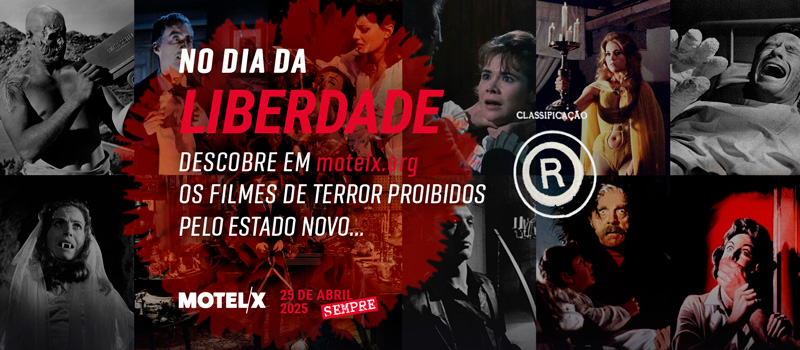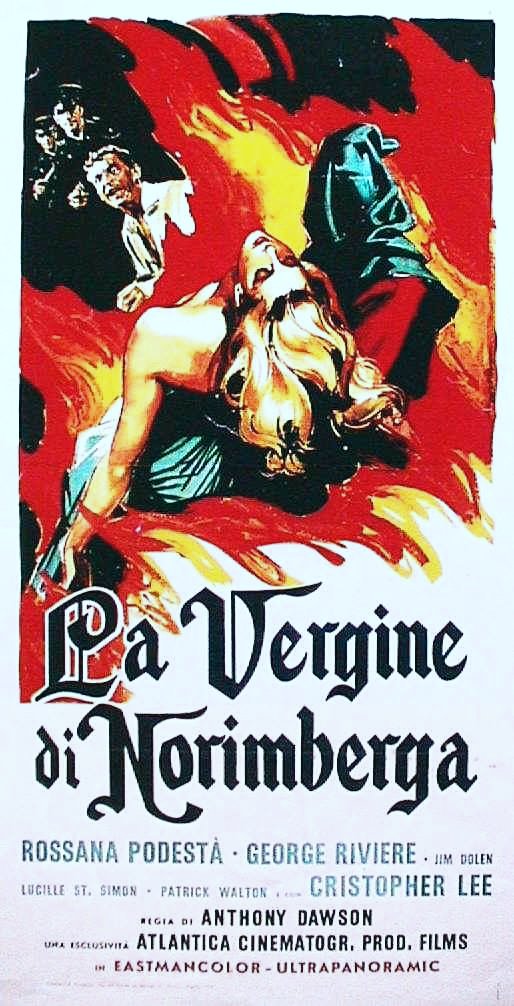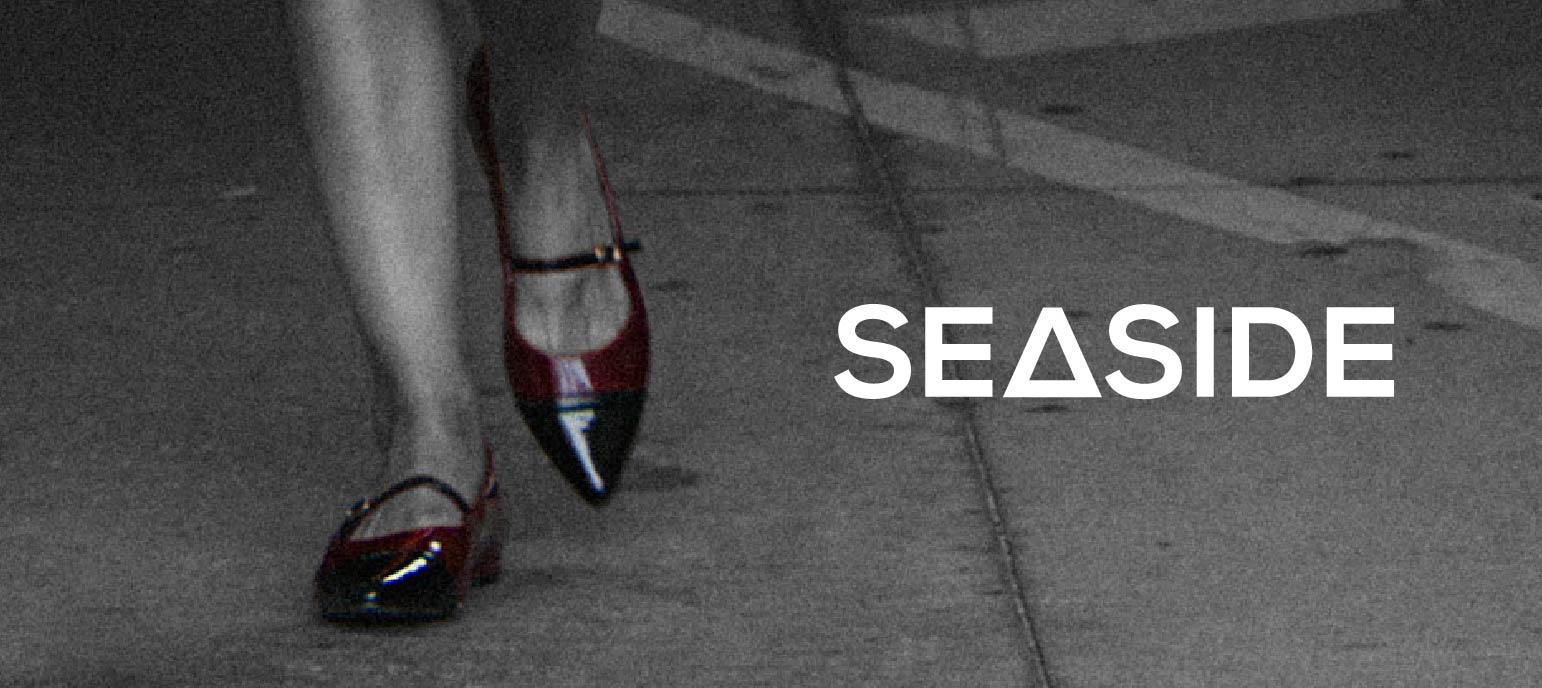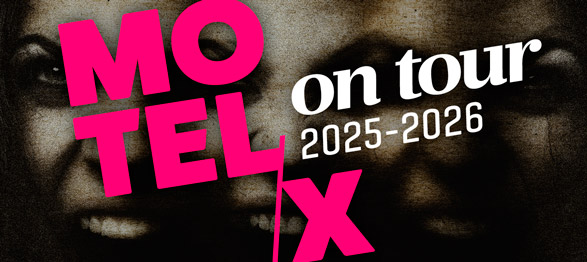News
April 25th, 2025: On the portuguese Freedom Day, discover the horror movies banned by the Estado Novo…
The Carnation Revolution, which freed Portugal from almost half a century of fascist oppression, will be 51 years old in 2025. MOTELX recommends, for the good of the Nation, celebrating Freedom with horror films!

Today is April 25th, 2025: Freedom Day in Portugal.
But the lessons of the 20th century teach us that freedom is something to be celebrated every day — which is why we say: “April 25th, ALWAYS.”
MOTELX is a film festival, and here we’ll be focusing on the seventh art — specifically horror cinema, our home turf... In the 48 years of murderous fascism leading up to the Carnation Revolution, the climate of political persecution and ideological repression in Portugal led to a fractured relationship between Portuguese society and cinema. Among the most affected genres was horror, which, as we’ll see next, was particularly unsettling to the Salazar regime.
Driven by a basic instinct for self-preservation, the Estado Novo dictatorship implemented absolute political, religious, ideological, and moral control through aggressive censorship bodies such as the Secretariado Nacional de Informação (SNI) and the Fundo Nacional de Cinema. In this atmosphere of cultural suffocation, only films deemed “representative of the Portuguese spirit, reflecting the psychology, customs, traditions, history, and collective soul of the people (...)” were eligible for production support. As for foreign films, the distributors often practiced self-censorship out of fear that their films would be banned — resulting in financial loss and potential suppression of their activity by the SNI. Beyond the censor’s blue pencil, distributors had to conduct prior analysis of film content, which significantly limited the selection of films worth importing.
Based on a list of films imported to Portugal between 1940 and 1970, provided to MOTELX by the National Archive of Torre do Tombo, a total of 4,866 films were submitted to the SNI for approval. Of these, 3,954 were censored with cuts, 641 were completely banned from screening, and only 271 were shown in full, without any alterations.
The horror genre, in particular, was a hotbed of conflict between distributors and censors, who clung to the “Guidelines for Cinematic Censorship” in a bid to save the Portuguese soul from its supposed immorality. Religious and moral concerns were frequently grounds for banning horror films, which — legend has it — were screened by the censors in the Rank Room of Cinema São Jorge. It was in this same room that the programming section called “For the sake of the Nation: Horror Films Forbidden by the Estado Novo” was concluded, a retrospective that was part of MOTELX’s 18th edition, celebrating the 50th anniversary of the 25th of April.
Over those three decades, only 23 horror films were submitted to the censors: just one was approved for screening without any cuts (see below), while 16 were outright banned. Of those 16, five were selected by the MOTELX programmers to be shown in the aforementioned section: The neo-realist horror of "Il Demonio", directed by Brunello Rondi — screenwriter of "La Dolce Vita" and "8½"; the only zombie film by Hammer Films, "The Plague of the Zombies", by John Gilling; the forgotten true crime gem "10 Rillington Place", by Richard Fleischer, featuring Sir Richard Attenborough as serial killer John Christie; the erotic, dreamlike, and gothic "Valerie and Her Week of Wonders", a cult classic by Czech filmmaker Jaromil Jireš; and in the cycle’s Surprise Screening, "The Nightcomers", a prequel to Henry James’s 1898 novella The Turn of the Screw, directed by Michael Winner and starring Marlon Brando.
We now reveal the remaining 11 horror films analyzed and expressly banned by the SNI censors:
1) "Horrors of the Black Museum" (Arthur Crabtree; 1959)

"Sheer horror for horror's sake ..."
"This infamously lurid horror begins with one of the most memorably vicious shocks of the 1950s fear-era (...) A tawdry catalogue of tortures, purple dialogue and risible acting (wooden Shirley Anne Field), this crudely effective melodrama is a British exploitation classic."
"A crude shocker."
2) "The hands of Orlac / As mãos de Orlac" (Edmond Gréville, 1960)

"Its most enduring quality is Veidt's tormented performance as Orlac."
"Peter Lorre's auspicious first appearance in a Hollywood-made film."
"A classic psychological thriller which charts one man's slow descent into madness."
3) "L`amante del vampiro / O vampiro e a bailarina" (Renato Polselli, 1960)

"an important footnote in the history of Italian horror for being among the first films to blatantly mix sex and horror"
4) "Doctor Blood`s coffin / O Abraço do morto" (Sidney Furie, 1961)

"Young children should not be encouraged to see the picture, in fact, it is likely to cause nightmares among sturdy adults"
"the first glimpse of the modern screen zombie – decayed and violent, rather than simply pale and aloof"
5) "Lo spettro / O espectro" (Riccardo Freda, 1964)

"Pictorially the film is a knock-out" "Measured, moody horror, let down by routine plot"
"a splendid exercise in Grand Guignol"
6) "Dracula, prince of darkness / Drácula, o príncipe da escuridão" (Terence Fisher, 1966)

"should please the following of this type of film and do all right at the wickets. Terence Fisher has directed it with his usual know-how and the screenplay by John Samson is a workmanlike job which provides a useful number of mild thrills and little enough of the misplaced yocks that sometimes creep into this sort of pic."
"perhaps the quintessential Hammer horror"
7) "I tre volti della paura/ As três faces do medo" (Mário Bava, 1963-1964)

"a good deal more sophisticated than usual horror fare"
"pictorially it's amazing, and even the script and dubbing are way above average."
"composed of three tales of expertly building suspense"
"a little masterpiece"
8) "La vergine di Norimberga" (Antonio Margheriti, 1963-1966)

"adds up to a highly enjoyable piece of nonsense"
"is worth it, especially if you like cold violence, as Margheriti pushes the limits with his tortures"
9) "Village of the giants" (Bert Gordon, 1965-1968)

"Alan Caillou's script keeps the action fast and the dancing swinging."
"best things about the film, are special effects and photographic trickery"
10) "Eye of the devil" (J. Lee Thompson, 1966-1967)
"Sharon Tate makes a significant visual impression"
11) "Histoires extraordinaires / Histórias extraordinárias" (Federico Fellini, Roger Vadim, Louis Malle, 1968-1975)

"Toby Dammit, the first new Fellini to be seen here since Juliet of the Spirits in 1965, is marvellous: a short movie but a major one."
"Three auteurs descend on the works of Poe, each putting on a ghoulish show -- adapting The Tomahawk Man's tales of dreams and fright, with Fellini's segment particularly out of sight."
Also, as a bonus, we reveal the only film on this list released uncut:
"Dracula has risen from the grave" Freddie Francis, 1969-1970

"succeeds by virtue of Francis' adventurous direction"
Horror cinema, bothersome due to its irreverent nature and tendency to clash with the status quo, faced the stigma of subjective and ignorant evaluation by censors, who justified their disapprovals with laconic and often laughable sentences:
"an attack on religious institutions";
"exceeds in images of horror...";
"demonology, with religious practices";
"sordid, of demonic violence with great social and moral implications";
"a black magic movie";
"aspects of sexuality shamelessly exploited"...
And the absolute winner: “In the name of the sanity of the viewers, we disapprove of the film.”
We understand, therefore, that the presence of horror cinema among us can be taken as a barometer of social freedom. And today, on the day we celebrate the Revolution that allowed MOTELX to exist, faithful to ourselves and the ideals of April, we recommend, to whoever follows us, "celebrate freedom with horror cinema".
25th of April, ALWAYS!
But the lessons of the 20th century teach us that freedom is something to be celebrated every day — which is why we say: “April 25th, ALWAYS.”
MOTELX is a film festival, and here we’ll be focusing on the seventh art — specifically horror cinema, our home turf... In the 48 years of murderous fascism leading up to the Carnation Revolution, the climate of political persecution and ideological repression in Portugal led to a fractured relationship between Portuguese society and cinema. Among the most affected genres was horror, which, as we’ll see next, was particularly unsettling to the Salazar regime.
Driven by a basic instinct for self-preservation, the Estado Novo dictatorship implemented absolute political, religious, ideological, and moral control through aggressive censorship bodies such as the Secretariado Nacional de Informação (SNI) and the Fundo Nacional de Cinema. In this atmosphere of cultural suffocation, only films deemed “representative of the Portuguese spirit, reflecting the psychology, customs, traditions, history, and collective soul of the people (...)” were eligible for production support. As for foreign films, the distributors often practiced self-censorship out of fear that their films would be banned — resulting in financial loss and potential suppression of their activity by the SNI. Beyond the censor’s blue pencil, distributors had to conduct prior analysis of film content, which significantly limited the selection of films worth importing.
Based on a list of films imported to Portugal between 1940 and 1970, provided to MOTELX by the National Archive of Torre do Tombo, a total of 4,866 films were submitted to the SNI for approval. Of these, 3,954 were censored with cuts, 641 were completely banned from screening, and only 271 were shown in full, without any alterations.
The horror genre, in particular, was a hotbed of conflict between distributors and censors, who clung to the “Guidelines for Cinematic Censorship” in a bid to save the Portuguese soul from its supposed immorality. Religious and moral concerns were frequently grounds for banning horror films, which — legend has it — were screened by the censors in the Rank Room of Cinema São Jorge. It was in this same room that the programming section called “For the sake of the Nation: Horror Films Forbidden by the Estado Novo” was concluded, a retrospective that was part of MOTELX’s 18th edition, celebrating the 50th anniversary of the 25th of April.
Over those three decades, only 23 horror films were submitted to the censors: just one was approved for screening without any cuts (see below), while 16 were outright banned. Of those 16, five were selected by the MOTELX programmers to be shown in the aforementioned section: The neo-realist horror of "Il Demonio", directed by Brunello Rondi — screenwriter of "La Dolce Vita" and "8½"; the only zombie film by Hammer Films, "The Plague of the Zombies", by John Gilling; the forgotten true crime gem "10 Rillington Place", by Richard Fleischer, featuring Sir Richard Attenborough as serial killer John Christie; the erotic, dreamlike, and gothic "Valerie and Her Week of Wonders", a cult classic by Czech filmmaker Jaromil Jireš; and in the cycle’s Surprise Screening, "The Nightcomers", a prequel to Henry James’s 1898 novella The Turn of the Screw, directed by Michael Winner and starring Marlon Brando.
We now reveal the remaining 11 horror films analyzed and expressly banned by the SNI censors:
1) "Horrors of the Black Museum" (Arthur Crabtree; 1959)

"Sheer horror for horror's sake ..."
"This infamously lurid horror begins with one of the most memorably vicious shocks of the 1950s fear-era (...) A tawdry catalogue of tortures, purple dialogue and risible acting (wooden Shirley Anne Field), this crudely effective melodrama is a British exploitation classic."
"A crude shocker."
2) "The hands of Orlac / As mãos de Orlac" (Edmond Gréville, 1960)

"Its most enduring quality is Veidt's tormented performance as Orlac."
"Peter Lorre's auspicious first appearance in a Hollywood-made film."
"A classic psychological thriller which charts one man's slow descent into madness."
3) "L`amante del vampiro / O vampiro e a bailarina" (Renato Polselli, 1960)

"an important footnote in the history of Italian horror for being among the first films to blatantly mix sex and horror"
4) "Doctor Blood`s coffin / O Abraço do morto" (Sidney Furie, 1961)

"Young children should not be encouraged to see the picture, in fact, it is likely to cause nightmares among sturdy adults"
"the first glimpse of the modern screen zombie – decayed and violent, rather than simply pale and aloof"
5) "Lo spettro / O espectro" (Riccardo Freda, 1964)

"Pictorially the film is a knock-out" "Measured, moody horror, let down by routine plot"
"a splendid exercise in Grand Guignol"
6) "Dracula, prince of darkness / Drácula, o príncipe da escuridão" (Terence Fisher, 1966)

"should please the following of this type of film and do all right at the wickets. Terence Fisher has directed it with his usual know-how and the screenplay by John Samson is a workmanlike job which provides a useful number of mild thrills and little enough of the misplaced yocks that sometimes creep into this sort of pic."
"perhaps the quintessential Hammer horror"
7) "I tre volti della paura/ As três faces do medo" (Mário Bava, 1963-1964)

"a good deal more sophisticated than usual horror fare"
"pictorially it's amazing, and even the script and dubbing are way above average."
"composed of three tales of expertly building suspense"
"a little masterpiece"
8) "La vergine di Norimberga" (Antonio Margheriti, 1963-1966)

"adds up to a highly enjoyable piece of nonsense"
"is worth it, especially if you like cold violence, as Margheriti pushes the limits with his tortures"
9) "Village of the giants" (Bert Gordon, 1965-1968)

"Alan Caillou's script keeps the action fast and the dancing swinging."
"best things about the film, are special effects and photographic trickery"
10) "Eye of the devil" (J. Lee Thompson, 1966-1967)
"Sharon Tate makes a significant visual impression"
11) "Histoires extraordinaires / Histórias extraordinárias" (Federico Fellini, Roger Vadim, Louis Malle, 1968-1975)

"Toby Dammit, the first new Fellini to be seen here since Juliet of the Spirits in 1965, is marvellous: a short movie but a major one."
"Three auteurs descend on the works of Poe, each putting on a ghoulish show -- adapting The Tomahawk Man's tales of dreams and fright, with Fellini's segment particularly out of sight."
Also, as a bonus, we reveal the only film on this list released uncut:
"Dracula has risen from the grave" Freddie Francis, 1969-1970

"succeeds by virtue of Francis' adventurous direction"
Horror cinema, bothersome due to its irreverent nature and tendency to clash with the status quo, faced the stigma of subjective and ignorant evaluation by censors, who justified their disapprovals with laconic and often laughable sentences:
"an attack on religious institutions";
"exceeds in images of horror...";
"demonology, with religious practices";
"sordid, of demonic violence with great social and moral implications";
"a black magic movie";
"aspects of sexuality shamelessly exploited"...
And the absolute winner: “In the name of the sanity of the viewers, we disapprove of the film.”
We understand, therefore, that the presence of horror cinema among us can be taken as a barometer of social freedom. And today, on the day we celebrate the Revolution that allowed MOTELX to exist, faithful to ourselves and the ideals of April, we recommend, to whoever follows us, "celebrate freedom with horror cinema".
25th of April, ALWAYS!




